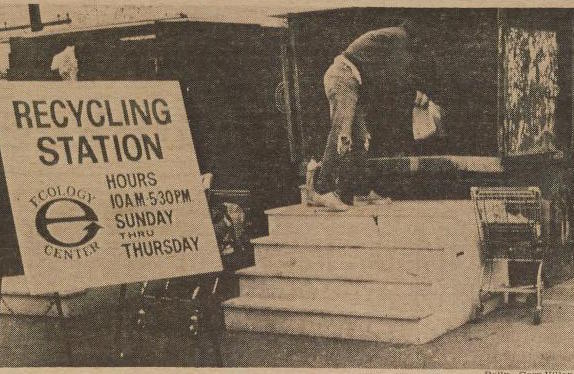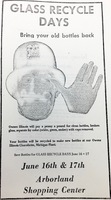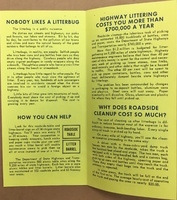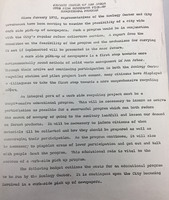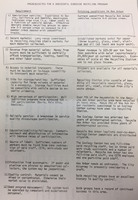Recycle Ann Arbor
Throughout the 1970s, ENACT and the Ecology Center sought to establish a recycling system in Ann Arbor. In the decade prior, just a handful of cities had implemented recycling programs. The first forms of recycling projects involved residents bringing their recyclable goods—namely glass and newspaper in the early years—to a designated location to be purchased by different manufacturing companies. In 1970, ENACT and the Ecology Center created Ann Arbor's first recycling station. During the rest of the 1970s, ENACT and the Ecology Center prepared to establish a curbside recycling pickup program and in 1977, Recycle Ann Arbor was born. Since the 1980s, Recycle Ann Arbor has expanded its geographic reach, as well as included many new recyclable materials such as car batteries, and hard-cover books.
The ENACT Teach-In of March 1970 included a major protest and clean-up of non-returnable cans and bottles. In June, in order to test whether establishing a glass recycling program in Ann Arbor could be successful, ENACT partnered with Owens-Illinois Glass Co. who purchased glass from Ann Arbor residents at one penny per pound. The event lasted for two days and Owens-Illinois Glass Co. purchased over 1,000 pounds of glass bottles. Almost a quarter of the money raised by the Ann Arbor community was donated to ENACT in order to help establish the Ecology Center. The successes of this program showed the Ann Arbor community and the state of Michigan that a successful recycling program is possible. Additionally, the Ecology Center promoted the Glass Recycling Program as an example of how to implement community recycling programs beyond Ann Arbor.
The Ecology Center's bottle recycling station was the first of its kind nationwide. From September 1970 to May 1971, during its first eight months of operation, residents brought more than 2 million pounds of glass to the center. The Owens-Illinois Glass Co. purchased the glass bottles at a rate of 1/2 cent per pound and paid out over $8,000 (almost $50,000 in 2017 dollars) to individuals and community organizations during the initial period. Russ Linden, the director of the Ecology Center's recycling project, argued that traditional waste disposal was more than harmful to the environment: "much of that solid waste can be turned to positive benefits—it is valuable material and recycling it conserves energy and natural resources," while also turning a profit. The Ecology Center also worked on establishing a city-wide, curbside pickup recycling program and began lobbying the legislature for a Bottle Bill that would require a 10 cent deposit on bottles purchased. This recycling station, therefore, was instrumental in prompting ecological and renewable change throughout Ann Arbor and state-wide.
Prior to the 1970s, it was very common for individuals to throw their garbage, bottles, and cans out the window while they were driving. As the recycling movement gained steam statewide, the Michigan Department of State Highways and Transportation published pamphlets such as these to raise awareness of the negative ramifications of littering. In 1973, the state legislature of Michigan amended the Michigan State Anti-Litter Law to establish a fine of up to $400 and/or 90 days in jail. These severe measures were enacted to promote recycling and maintain the beauty of the state. Additionally, this pamphlet mentions how costly it is to litter. Thousands of taxpayers' dollars were going towards paying for individuals to sort through trash found on the side of the road. As the State of Michigan raised awareness and enforced fines for littering, the recycling movement continued to grow.
The Ecology Center worked closely with the city of Ann Arbor to establish a curbside recycling program that would accompany the regular trash pick-up. In order to accomplish this goal, the Ecology Center created an educational program for all Ann Arbor residents regarding recycling, in recognition that curbside service would only be successful if there were a high participation rate. The agreement with the city began with recycling newspapers, with the idea that this change would eventually lead to "more environmentally sound methods of solid waste management in Ann Arbor." The Ecology Center had the goal of increasing participation over time, so they wanted to develop metrics to track the program's progress, as well as to see which demographics had the lowest participation rate. By educating the Ann Arbor population, the Ecology Center was able to engrain recycling into the city's culture.
Originally, the Recycling Station was located near a construction company until a site was donated in Arborland. There, it grew rapidly and began handling newspapers as well as other aluminum and glass recyclables. The Recycling Station employed workers who had recently received misdemeanors for small crimes and were required to do community service work. Mike Schechtman, the second director of the Ecology Center in the early 1970s, explains in this interview how the Recycling Station was a large source of revenue for the Ecology Center, which is why it was advantageous that the location was only about 70 miles away from a glass recycling plant. Low transportation costs allowed the Ecology Center to bring in more money; however, they realized that it was better for the environment to promote reuse of bottles, rather than recycling them. This belief, in turn, led to the Bottle Bill effort.
In the late 1970s, the Ecology Center's recycling program became a separate organization called Recycle Ann Arbor, which continued to work closely with the city government. In this document, the Ecology Center and Recycle Ann Arbor reflected on the growth of the initiative over the previous decade and the "prerequisites for a successful curbside recycling program." Their data showed that 70 percent of Ann Arbor residents had participated in the curbside recycling program and 25 percent had brought materials directly to the Recycling Station. Both the Ecology Center and Recycle Ann Arbor continued to promote community education through door-to-door campaigns, but they also asked the City Council to pass an ordinance to strengthen the system and offset more of the costs. Through such efforts, the Ecology Center and its Recycle Ann Arbor spin-off created one of the most effective recycling systems in the nation during the 1970s.
Sources
Ecology Center of Ann Arbor Records, Bentley Historical Library, University of Michigan
West Michigan Environmental Action Council Records, Bentley Historical Library, University of Michigan
Michigan Daily Digital Archives
Recycle Ann Arbor, https://recycleannarbor.org/
Interview of Mike Schechtman by Matt Lassiter, November 17, 2017, by remote videorecording

